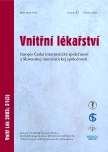Urgent endoscopic papilosphincterotomy in individuals older than 70 years
Authors:
Petr Dítě 1; Z. Papík 2; M. Kunovská 1; I. Novotný 1; Bohuslav Kianička 3; P. Piskač 4; V. Zbořil 1; M. Zavoral 5
Authors‘ workplace:
Interní gastroenterologická klinika FN Brno, pracoviště Bohunice, přednosta prof. MUDr. Petr Dítě, DrSc.
1; II. interní klinika Lékařské fakulty UK a FN, Hradec Králové, přednosta prof. MUDr. Jaroslav Malý, CSc.
2; Gastroenterologické oddělení FN u sv. Anny, Brno, přednosta prim. MUDr. Vladimír Bednařík
3; II. chirurgická klinika Lékařské fakulty MU a FN u sv. Anny, Brno, přednosta doc. MUDr. Jindřich Leypold, CSc.
4; II. interní oddělení, Klinika gastroenterologie a hepatologie 1. lékařské fakulty UK a ÚVN, Praha, přednosta doc. MUDr. Miroslav Zavoral, Ph. D.
5
Published in:
Vnitř Lék 2005; 51(5): 529-532
Category:
Original Contributions
Overview
Therapeutic endoscopy of acute pancreatobiliary conditions is represented in absolute majority of cases by endoscopic papilosphincterotomy performed after verification of finding in biliary duct and pancreatic duct by means of endoscopic retrograde cholangiopancreatography. Endoscopic operation is, of course, invasive performance that burdens the patients; therefore it is also accompanied with possible complications. In elderly individuals a risk factor of performance is undoubtedly polymorbidity, especially cardiovascular and bronchopulmonary diseases. In prospective study with individuals older than 70 years with acute cholangitis and acute biliary pancreatitis we evaluated performance safety and its effectivity as regards to the influence on the course of disease. We demonstrated that endoscopic papilosphincterotomy in mentioned conditions is safe performance, significantly favourably inflicting further development of the disease even in elderly patients. Nevertheless it is accepted that this performance in risk groups of individuals should be performed in the site, where the doctor-endoscopist has enough experience and the site is provided with the intensive medical care facility.
Key words:
pancreatitis – cholangitis – endoscopic papilotomy – elderly population
Sources
1. Bonder J, Nix GAJJ, de Ridder MAJ. Endoscopic papilotomy for common bile duct stones factors influencing the complication rate. Endoscopy 1994; 26: 209–216.
2. Classen M, Demling L. Endoskopishe Sphinkerotomie der Papilla Vater und Steinextraktion aus dem Ductus choledocus. Dtsch Med Wochenschr 1974; 99: 469–477.
3. Cotton PB, Wiliams CB. Practical Gastrointestinal Endoscopy. Oxford: Blackwell Scientific Publications 1992.
4. Cotton PB, Lehmann G, Vennes J et al. Endoscopic sphincterotomy complication and their management an attempt at consensus. Gastrointest Endosc 1991; 10: 383–393.
5. Cotton PB. Stents for stones: short-term good, long-term uncertain. Gastrointest Endosc 1995; 42: 272–274.
6. Fan ST, Lai ESC, Mok FPT et al. Early treatment of acute biliary pancreatitis by endoscopic papilotomy. N Engl J Med 1993; 328: 228–232.
7. Freeman ML, Nelson DR, Sherman S et al. Complications of endoscopic biliary sphincterotomy. N Engl J Med 1996; 335: 909–918.
8. Fölsch UR, Nitsche R, Ludtke R et al. and the German Study Group on Acute Biliary Pancreatitis. Early ERCP and papillotomy compared with conservative treatment for acute biliary pancreatitis. N Engl J Med 1997; 336: 237–242.
9. Chopra KB, Peters RA, O’Toole PA et al. Randomized study of endoscopic biliary endoprosthesis versus duct clearance for bile duct stones in high risk patients. Lancet 1996; 348: 791–793.
10. Lee JG, Leung JW. Endoscopic management of common bile duct stones. Gastrointest Endosc Clin North Am 1996; 6: 43–45.
11. Neoptolemus JP, London NJ, James D et al. Controlled trial of urgent endoscopic retrograde cholangiopancreatography and endoscopic sphincterotomy versus conservative treatment for acute pancreatitis due gallstones. Lancet 1998; ii: 979–983.
12. Nowak A, Nowakowska-Dulawa E, Marck T et al. Final results of the prospective, randomized controled study on endoscopic sphincterotomy versus conventional management in acute biliary pancreatitis. Gastroenterology 1995; 108: A380.
13. Ponsky JL. Endoscopic management of common bile duct stones. World J Sug 1992; 16: 1060–1065.
14. Seitz U, Bapaye A, Bohnacker S et al. Adavances in therapeutic endoscopic treatment of common bile duct stones. World J Surg 1998; 22: 1133–1144.
15. Skála I, Pirk F, Skála J. Endoskopické léčebné výkony na Vaterské papile a žlučovodech. Novinky v medicíně. Praha: Avicenum 1990.
16. Van Steenbergen W, Pelemans W, Fevery J. Endoscopic biliary endoprosthesis in elderly patients with large bile duct stones. A long-term follow-up. J Am Geriatric Soc 1992; 40: 57–60.
17. Vavrečka A. Diagnostická a liečebná endoskopia žlučových ciest a pankreasu. Martin: Osvieta 1983.
Labels
Diabetology Endocrinology Internal medicineArticle was published in
Internal Medicine

2005 Issue 5
Most read in this issue
- Acute myocarditis, prevalence, diagnosis and treatment in local hospital
- Vasospastic angina pectoris – pathogenesis, diagnostics and treatment
- Our experience in the treatment of membranous nephropathy with cyclosporine
- Pneumology problems of patients with diabetes mellitus
